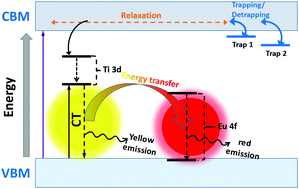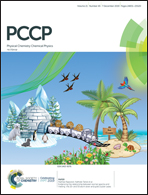A comprehensive study of the red persistent luminescence mechanism of Y2O2S:Eu,Ti,Mg†
Abstract
Y2O2S:Eu,Ti,Mg, a persistent luminescence (PersL) material that exhibits eye-sensitive red emission for longer than 4–5 h, has attracted much attention and has been intensively researched over the past decade. If it is figured out how to prolong its decay time for longer than 8 h, the amazing candle-like red PersL performance, once lit, can illuminate a room all night without electricity. However, the PersL mechanism is still confusing, since different investigators have their own unique understanding about it based on their personal experimental observations. In this work, a more comprehensive and detailed investigation of the PersL mechanism is carried out, based on the defect levels induced by Eu, Ti, and Mg impurities and anion vacancies, using first-principles calculations. Our calculated results suggest that the empty spin-down 4f levels of Eu3+ appear in the band gap, while the occupied spin-up 4f levels are just below the valence band maximum (VBM). The 3d levels of Ti4+ are located in the band gap, with the highest levels around 1.4 eV below the conduction band minimum (CBM). Positively charged anion vacancies were found to induce empty defect levels just below the CBM and so could serve as electron trap centers, which prolong the lifetimes of excited electrons and lead to the PersL of the Ti4+ ion. When Eu3+ is co-doped with Ti4+, the energy of the excited Ti4+ ions is transferred to Eu3+. This mechanism can explain well most of the experimental observations that have appeared in the literature over the past decade. The obtained PersL mechanism is very clear in terms of the roles played by most types of defect, so we hope it can provide physical understanding and create intrigue around the idea of practical guidelines for the design of new red PersL materials in the future.



 Please wait while we load your content...
Please wait while we load your content...